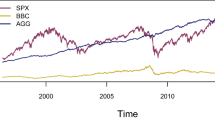Abstract
This paper presents preliminary results of a computational experiment with the strategy-based approach and the risk-based approach to portfolio margining with the purpose to clarify which one yields lower margin requirements under different scenarios. There exists a widespread opinion that the risk-based approach is always a winner in this competition, and therefore the strategy-based approach must be disqualified as outdated. However, the results of our experiment with portfolios of stock options show that, in many practical situations, the strategy-based approach yields substantially lower margin requirements in comparison with the risk-based approach.
Access this chapter
Tax calculation will be finalised at checkout
Purchases are for personal use only
Preview
Unable to display preview. Download preview PDF.
Similar content being viewed by others
References
Rudd, A., Shroeder, M.: The calculation of minimum margin. Manage. Sci. 28, 1368–1379 (1982)
Matsypura, D., Oron, D., Timkovsky, V.G.: Option spreads: centipedes that cannot have more than 134 legs. Working paper, The University of Sydney (2007)
Author information
Authors and Affiliations
Editor information
Editors and Affiliations
Rights and permissions
Copyright information
© 2010 Springer-Verlag Berlin Heidelberg
About this paper
Cite this paper
Coffman, E.G., Matsypura, D., Timkovsky, V.G. (2010). A Computational Study of Margining Portfolios of Options by Two Approaches. In: Prasad, S.K., Vin, H.M., Sahni, S., Jaiswal, M.P., Thipakorn, B. (eds) Information Systems, Technology and Management. ICISTM 2010. Communications in Computer and Information Science, vol 54. Springer, Berlin, Heidelberg. https://doi.org/10.1007/978-3-642-12035-0_32
Download citation
DOI: https://doi.org/10.1007/978-3-642-12035-0_32
Publisher Name: Springer, Berlin, Heidelberg
Print ISBN: 978-3-642-12034-3
Online ISBN: 978-3-642-12035-0
eBook Packages: Computer ScienceComputer Science (R0)




